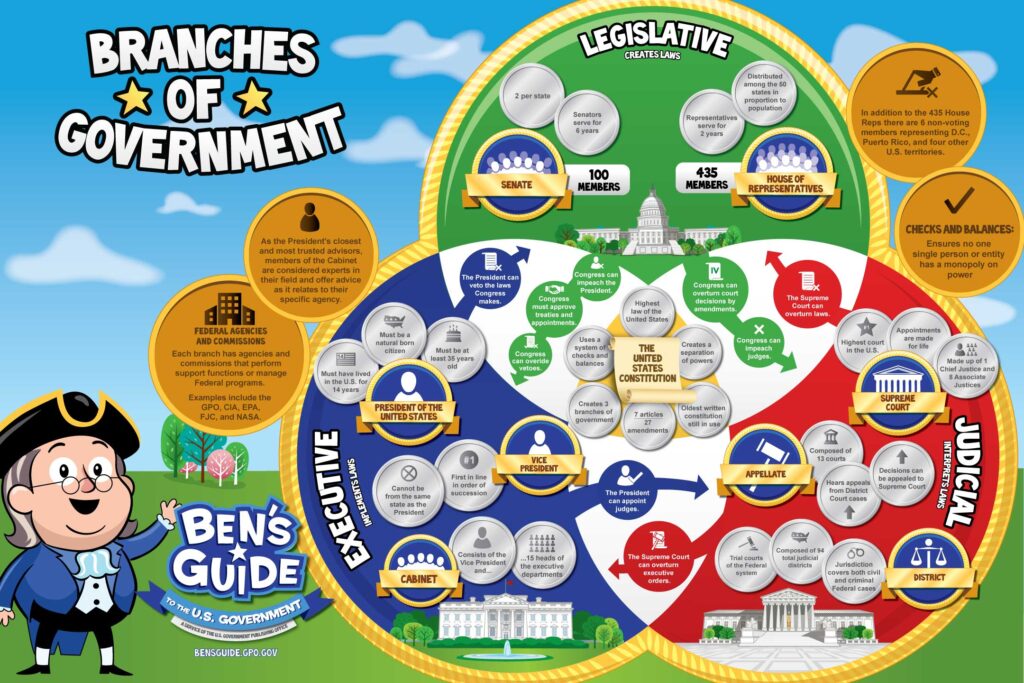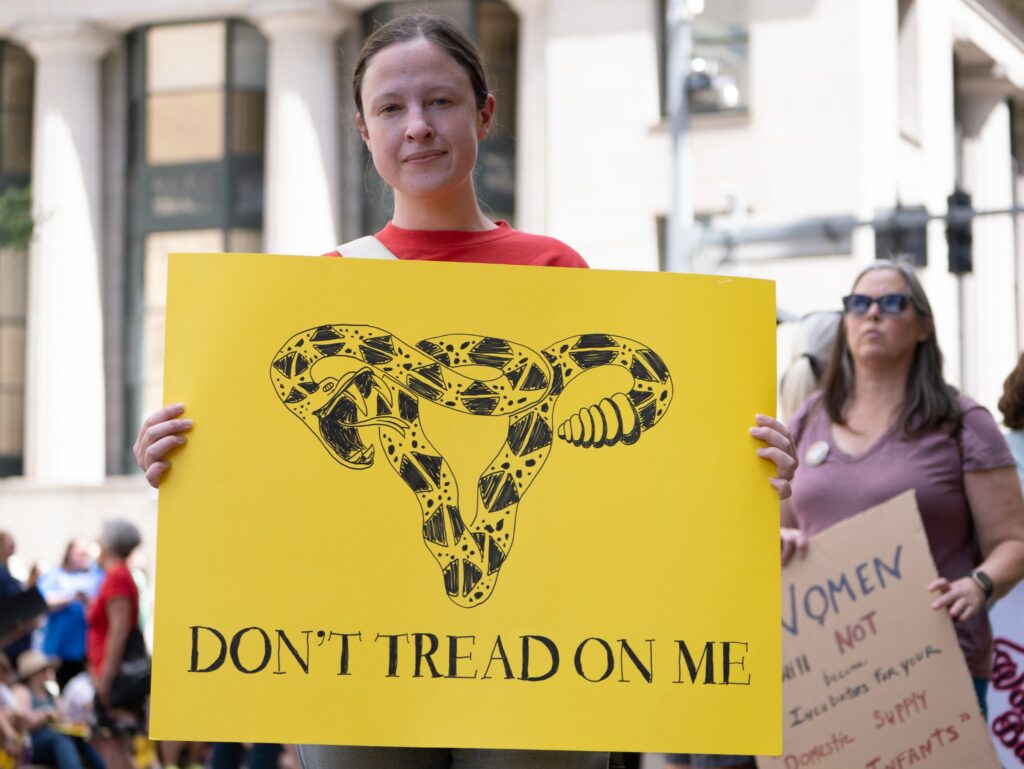Part 4 – Shifting Authority
Our government – both on the federal level and the Pennsylvania state level – is divided into three branches: the executive, the legislative, and the judicial. You may remember from social studies class that these three branches were devised to be equal, with separation of powers so that no one branch could gain too much authority. The legislative branch creates laws, the executive branch implements laws, and the judicial branch interprets laws. Each branch has power over the others in specific ways like a very complex game of rock, paper, scissors.[1]

Image credit: [2]
The executive branch, by nature of the power being concentrated in one person and his/her support staff (vice president, cabinet, etc.), tends to get the most attention from voters. The legislative branch gets some attention – as we are seeing this year with contentious senate races across the country – but there is still significantly less turnout for midterm elections than for presidential elections.[3] The branch that is the most obscure and least accountable to the public is the judicial branch. Judicial elections happen at the Pennsylvania state level, but those get the lowest turnout of the four-year election cycle, and the public has no direct involvement with who ends up on the bench of the US Supreme Court, as those individuals are appointed by the president.
Role of the Court
The firewall between the public and the federal judicial branch was intentional, as the judges were supposed to be impartial evaluators of the law and insulated from partisan politics and public popularity contests. Unfortunately, the makeup of the federal court system – the US Supreme Court and the lower district and appellate courts – has become one of the most politicized aspects of our government. Given that the Supreme Court has the power to overturn unconstitutional laws created by congress and unconstitutional executive orders created by the president, presidents tend to appoint justices whose decisions will be helpful to their own parties. And with the three conservative justices appointed by our last president, there is now a conservative supermajority on the Supreme Court.
Very simply put, justices who are more conservative tend to interpret the law explicitly as it was written, as it was intended by those who wrote it; justices who are more liberal tend to interpret the law as it applies to today’s world, which could be very different than the one in which the law was written. While the process of interpretation would seem to be very cut and dry (like a referee calling plays in a sporting event), there is indication that an individual justice’s personal beliefs can actually be significantly influential when it comes to that justice’s rulings.[4] And because of that, the more vague the law, the more room there is for interpretation by people who are, ultimately, still human.

Image credit: [5]
The executive branch certainly has the power to pack the bench with friendly justices who will be more likely to support policies of a given party, but we have also seen that the legislative branch can assert power in a different way, in which controversial state laws can be appealed all the way to the Supreme Court and result in rulings that can impact the entire country. We saw such a long play come to a head this year with Dobbs v. Jackson, in which a health care clinic challenged a 2018 Mississippi law that banned abortions after 15 weeks of pregnancy.[6] A lower court prevented enforcement of the law, citing the precedent of Planned Parenthood v. Casey (1992), which prevented states from banning abortions before fetal viability.[7] Casey relied on Roe v. Wade (1973), which stated that a woman’s right to an abortion was protected by the right to privacy guaranteed in the 14th Amendment.[8] After Dobbs was heard by the Supreme Court in December 2021, the court reversed the Dobbs ruling and overturned both Roe and Casey, stating that abortion is not a constitutional right, as the constitution does not specifically grant the right to an abortion.
Implications of Interpretations
The important thing to note in the context of this blog post and the interplay between those who make the laws and those who interpret the laws is that what happened in this instance was an intentional play by conservative legislators banking on a specific response by a conservative court. To drive home my point, multiple state legislatures set up trigger laws designed to severely restrict abortion access in anticipation of the Supreme Court’s ruling. The primary conservative talking points in the wake of the ruling were along the lines of “this is a good thing because now it’s up to the states to decide.” But many states had already decided, despite the fact that a majority of Americans did not want to see Roe overturned.[9]
This conservative supermajority in the supreme court, with more of a strict-constructionist approach makes voter involvement in legislative elections that much more crucial wherever laws are open to interpretation. The impacts of this year’s court decisions did not only eliminate federal protections of reproductive rights, but also limited the EPA’s ability to regulate carbon emissions from power plants (West Virginia v. The Environmental Protection Agency),[10] granting more power to the states in both cases. On the other hand, the court also landed in favor of specifically enumerated constitutional rights, such as First Amendment protections of prayer in schools (Kennedy v. Bremerton School District)[11] and Second Amendment protections of concealed carry for firearms (New York State Rifle and Pistol Association v. Bruen)[12]. These decisions hold with rights specifically granted by our founding fathers in the constitution, rather than relying on applications of their words to our modern world.[13]

Image credit: Mark Dixon [14]
On the Supreme Court’s docket for next year, there are multiple cases worth watching,[15] including one that could grant state lawmakers more power over federal election procedures (Moore v. Harper),[16] and one that could allow small businesses to deny services to marginalized groups based on personally held beliefs (303 Creative LLC v. Elenis).[17] We could be in the position of watching rights that were established by more liberal interpretations of the law erode in the coming years until specific protections are explicitly enshrined in legislation. And that is where we the voters come in. If any decisions made by the Supreme Court this year – or ones that are up for debate next year – concern you, you should be looking at where your legislative candidates stand on those issues and making your voice heard at the polls.
You have the right (the obligation, some would say) to elect candidates at the state and federal levels who represent your values. If you’re like me, you probably want representatives in office who will make it a priority to create more specific, commonsense, and equitable policies – but that will not happen without your involvement. So make sure you take a look at the spreadsheet below and get to know your options for November 8.
Thank you for reading.
And may the odds be ever in your favor.
[1] https://bensguide.gpo.gov/j-check-balance
[2] https://bensguide.gpo.gov/images/Branches-of-Government.jpg
[4] https://pubs.aeaweb.org/doi/pdfplus/10.1257/jep.35.1.97
[5] https://en.wikipedia.org/wiki/File:Graph_of_Bailey_Scores_of_Supreme_Court_Justices_1950-2011.png
[6] https://www.oyez.org/cases/2021/19-1392
[7] https://www.oyez.org/cases/1991/91-744
[8] https://www.oyez.org/cases/1971/70-18
[9] https://www.pbs.org/newshour/politics/majority-of-americans-dont-want-roe-overturned
[10] https://www.oyez.org/cases/2021/20-1530
[11] https://www.oyez.org/cases/2021/21-418
[12] https://www.oyez.org/cases/2021/20-843
[13] https://usafacts.org/articles/what-does-government-data-say-about-the-2022-supreme-court-decisions/
[14] https://www.flickr.com/photos/9602574@N02/52073429646/
[15] https://www.axios.com/2022/07/01/supreme-court-cases-2022
[16] https://www.oyez.org/cases/2022/21-1271
[17] https://www.oyez.org/cases/2022/21-476
0 Comments